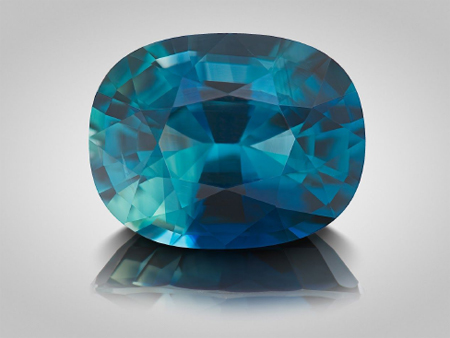
Top quality Australian teal sapphire of 6.11 carats,
courtesy of Navneet Gems & Minerals Ltd.co. Photograph by
Arjuna Irsutti
The Era for Teal
Widely known as teal, this dark cyan-like hue was originally named after the bluish-green stripe
around the eyes of an Eurasian duck. In recent years, the gem's mesmerizing marine hue -
reminiscent of serene oceans and the mysterious green of our lands has redefined the jewellery
market for unique colored gemstones, capturing the imaginations of consumers especially
amongst the millennial and Gen Z. The USA is amongst teal sapphire’s most ardent consumers,
followed by Australia, France, UK, and Asia. Public awareness regarding teal sapphires has
grown in the last five years and will continue to grow, says Navneet Agarwal, Marketing
Manager of Navneet Gems & Minerals Limited Co., a gem manufacturer based in Bangkok.
Like a Mermaid
Bold flashes of soft green mixed with a kiss of blue, teal sapphires have earned various trade
names like “Mermaid” sapphire. “Mermaid sapphires are a subset of teal sapphires which have
a specific color ratio of 50% blue and 50% green. Mermaid sapphires are the top color of teal
sapphires,” says Agarwal. He speculates that this 50-50 color ratio of blue and green may have
the potential to scale up in prices like a perfect padparadscha color. “Like padparadscha, each
teal sapphire appears to have a unique personality reflected in its color variations.”
The main sources of teal sapphires are Montana, Australia, Madagascar, Ethiopia and Nigeria,
all equally important with differences in tone, intensity and brightness. Teal sapphires have been actively mined for more than 100 years in Montana’s Rock Creek and Potentate Mining is
among the industry’s premier local producers. “Montana’s teal sapphires have sporadically been
on the market since the late 1990s. When we tested the market in 2014-2015, there was
general ambivalence and dismissiveness about these unique colors from the Rock Creek
Sapphires but we have seen a paradigm shift,” s ays Warren Boyd of Potentate Mining. He
adds, “We could accredit this surge in interest to the discovery of the first teal sapphires in
Montana.” According to Agarwal, “ the interest also piqued when Australian teal sapphires were
discovered with their unique coloring, yielding both teal and only a few rare mermaid sapphires
of excellent quality. The challenge lies in finding rare top-grade teal or “Mermaid” sapphires of
superior clarity and cut. “We source our teal sapphires from well-known mines all over the world.
The choice of source depends on the quality and their ethical sourcing.”
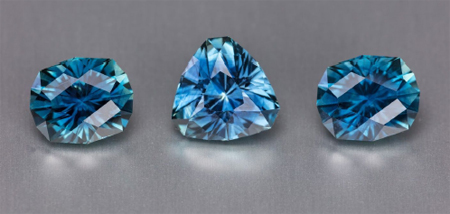
Teal Montana Rock Creek Sapphires ™
courtesy of Potentate Mining LLC. Gem cutting and photography by Jeffrey
Hapeman - Earth’s Treasury.
Most teal sapphires from Montana and Australia are responsibly sourced using mechanical
mining to ensure processes are closely regulated throughout the supply chain. Whereas those
from Madagascar and Nigeria are predominantly mined by artisanal miners. “Its exquisite color
and rising popularity is also helping them establish new markets for this non-traditional, unique
color sapphire,” says Agarwal.
Caleb B. Quashen International, a gem supplier specialising in ethically sourced obscure gems,
helps to support African artisanal miners. “We see purpose and beauty in all the different
qualities of teal sapphires and pride ourselves in using stones with eye visible inclusions. We do
not cherry pick, instead we buy it all and that means the full unearthing effort.” Caleb adds that
“ every origin has the ability to produce spectacular specimens and the veteran eye can get
pretty good at noting the distinctions.”
Magnetic Appeal
With the emergence of the alternative bridal market, teal sapphires are providing a new palette
for designers and consumers who gravitate towards less popular gems in search of jewels that
define their individuality.
There are multiple reasons for their appeal. First, their unique coloring due to a perfect balance
of titanium and iron, makes them a more personalised alternative to the traditional blue sapphire
engagement ring. Second, c ompared to top blue sapphires, teal sapphires are much more
reasonably priced. Third, besides sharing a color with lagoon tourmaline from Afghanistan, Teal
sapphires have greater hardness with 9 on the Mohs scale and higher refractive index, opening
up great possibilities for the engagement market. Slovenia-based jewelry brand Capucinne,
specializes in alternative engagement rings is a prolific employer of teal sapphires. “ We liked
these stones from the start as they were the perfect solution for those looking for something
blue but wanted a modern and deeper undertone to the classic blue sapphire.” Apart from color,
clarity, cut, the stone’s origin due to consumer patriotism also plays a role in their purchasing
decisions . Regarding Montana teal sapphires, Boyd thinks “American consumers are keen to
purchase American-mined products that are recovered in an environmentally responsible and
ethical manner.” Capucinne also says “what matters most about origin to us is that they are
responsibly and ethically sourced, whether they’re from Montana, Australia, Nigeria or
Madagascar.”
Teal sapphires offer something new in the world of gemstones and the desire to possess them
will only intensify as more gem and jewellery lovers become enchanted by their beauty.
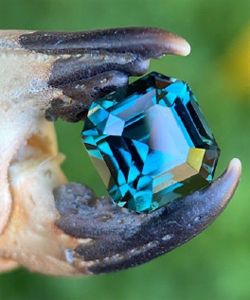
Emerald cut teal sapphire from Gombe, Nigeria, courtesy of
Caleb B. Quashen International.
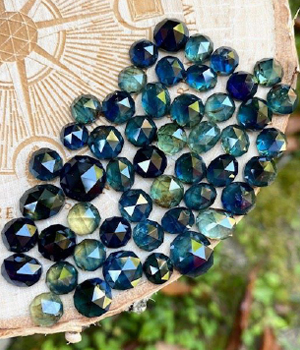
Rose cut teal sapphires from Gombe, Nigeria, courtesy of Caleb B. Quashen International.
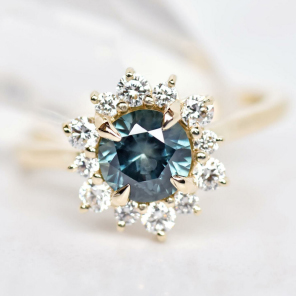 Marisol Teal sapphire engagement ring by Valerie
Madison.
Marisol Teal sapphire engagement ring by Valerie
Madison.
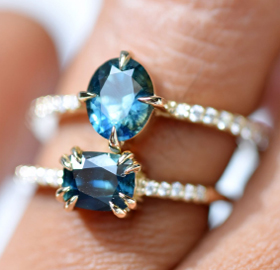 Teal sapphire engagement ring styles by Valerie
Madison.
Teal sapphire engagement ring styles by Valerie
Madison.
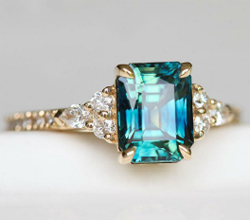 Darlene Radiant Teal sapphire engagement ring by
Capucinne.
Darlene Radiant Teal sapphire engagement ring by
Capucinne.